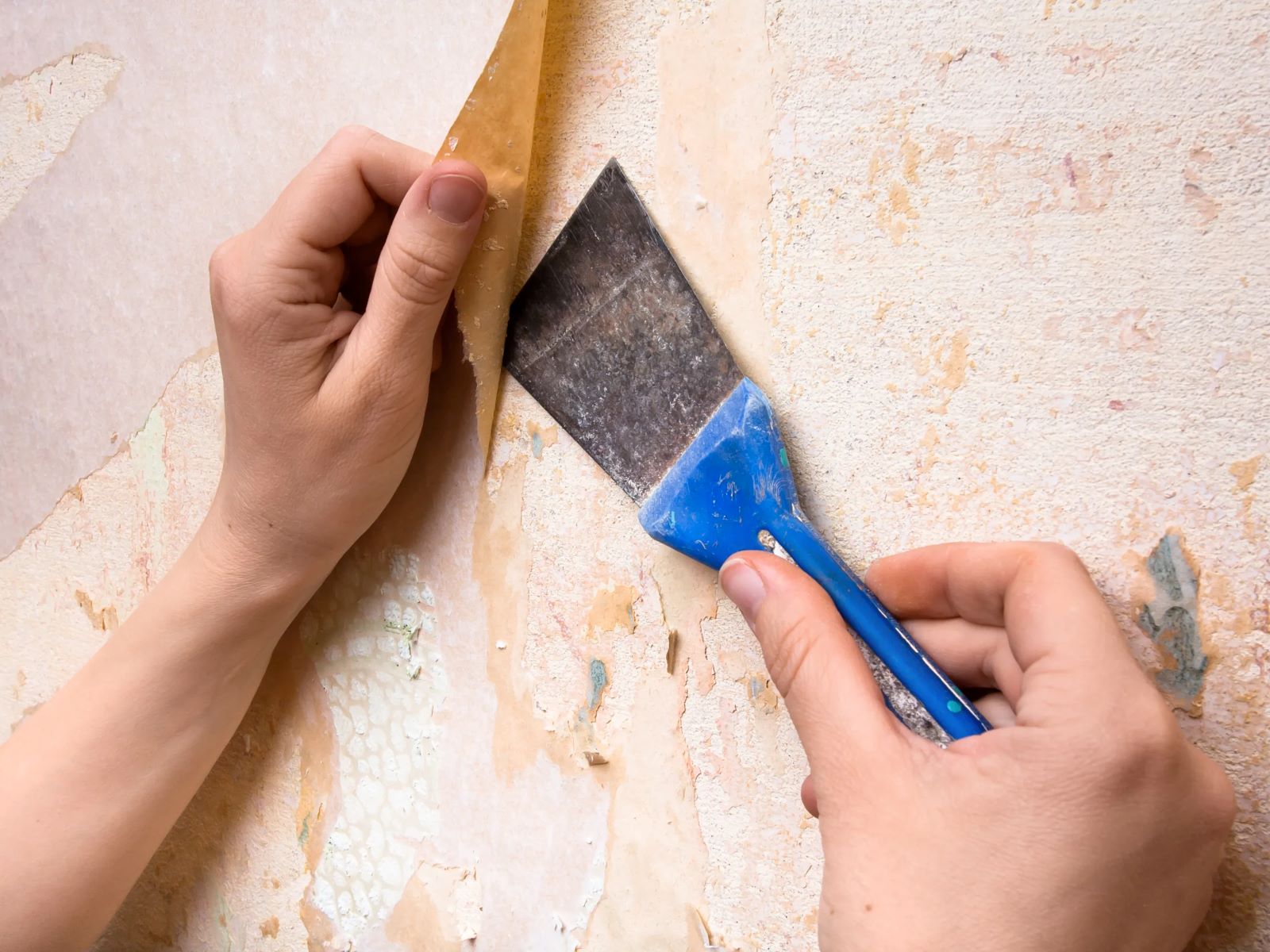Home>Home and Garden>The Ultimate Guide To Removing Wood Stain


Home and Garden
The Ultimate Guide To Removing Wood Stain
Published: January 18, 2024
Discover the best tips and techniques for removing wood stain in our comprehensive guide. Perfect for home and garden enthusiasts looking for effective solutions.
(Many of the links in this article redirect to a specific reviewed product. Your purchase of these products through affiliate links helps to generate commission for Regretless.com, at no extra cost. Learn more)
Table of Contents
Introduction
Wood stain can add a touch of elegance and character to furniture, decking, or other wooden surfaces. However, there are times when you may want to remove or change the existing wood stain. Whether it's to repair a blemish, update the color, or simply restore the wood to its natural beauty, the process of removing wood stain requires careful consideration and the right techniques. In this comprehensive guide, we will explore the various methods and considerations for effectively removing wood stain from different wooden surfaces.
Wood stain removal is a task that demands attention to detail and a methodical approach. It's important to understand the type of wood and the existing stain before embarking on the removal process. Different types of wood and stains may require different removal methods to achieve the best results without causing damage to the wood itself. By gaining a deeper understanding of the nature of wood stain and the methods available for its removal, you can confidently tackle this task and restore your wooden surfaces to their former glory.
In the following sections, we will delve into the intricacies of wood stain removal, starting with an exploration of the different types of wood stain and the factors that influence the choice of removal method. We will then discuss the essential steps for preparing the wood surface before beginning the removal process. Subsequently, we will explore various methods for removing wood stain, including sanding, chemical stripping, heat application, and natural removal techniques. Additionally, we will provide insights into the aftercare and refinishing process to ensure that the wood surface is properly treated and restored post-stain removal.
By the end of this guide, you will have a comprehensive understanding of the nuances involved in removing wood stain, empowering you to make informed decisions and execute the most suitable method for your specific wood stain removal needs. Whether you are a seasoned DIY enthusiast or a homeowner looking to revitalize your wooden furniture or decking, this guide will equip you with the knowledge and confidence to undertake the wood stain removal process effectively and efficiently.
Read more: How To Get Heat Stains Out Of Wood
Understanding Wood Stain
Wood stain is a versatile and popular product used to enhance the appearance of wooden surfaces while providing protection against the elements. It is available in a wide range of colors and formulations, allowing individuals to customize the look of their furniture, flooring, decks, and other wooden structures. Understanding the characteristics and types of wood stain is crucial when considering the process of removing it.
Wood stain penetrates the surface of the wood, enhancing its natural grain and color. Unlike paint, which forms a protective film on the surface, stain is designed to seep into the wood, creating a semi-transparent or transparent finish that allows the natural beauty of the wood to shine through. This characteristic makes stain removal a more intricate process compared to paint removal, as the stain becomes integrated into the wood fibers.
There are different types of wood stain, each with its unique properties and applications. Oil-based stains, for example, offer deep penetration and durability, making them suitable for high-traffic areas such as floors and outdoor furniture. On the other hand, water-based stains are known for their quick drying time and low odor, making them a popular choice for indoor projects. Additionally, gel stains provide a thicker consistency, ideal for vertical surfaces and achieving a more uniform finish.
Furthermore, wood stains come in a variety of opacities, ranging from clear to solid. Transparent and semi-transparent stains allow the natural wood grain to show through, while semi-solid and solid stains provide more extensive color coverage, effectively concealing the wood grain. Understanding the opacity of the existing wood stain is essential when planning its removal, as it influences the visibility of the underlying wood and the level of effort required for complete removal.
In addition to the type and opacity of the stain, it is vital to consider the wood species itself. Different types of wood absorb stain differently due to variations in their grain patterns and porosity. For instance, hardwoods such as oak and mahogany tend to absorb stain more evenly compared to softwoods like pine and cedar, which may result in a blotchy appearance if not properly conditioned before staining.
By comprehending the nature of wood stain, including its types, opacities, and interactions with various wood species, individuals can make informed decisions when selecting the most suitable method for removing the existing stain. This understanding forms the foundation for successful wood stain removal, ensuring that the process is approached with precision and tailored to the specific characteristics of the wood and its current stain.
Preparing for Wood Stain Removal
Before embarking on the process of removing wood stain, it is crucial to adequately prepare the wooden surface to ensure the best possible outcome. Proper preparation not only facilitates the removal process but also minimizes the risk of damaging the wood. Here are the essential steps to prepare for wood stain removal:
-
Assess the Wood Surface: Begin by thoroughly examining the wood surface to identify the type of wood and the characteristics of the existing stain. Take note of any imperfections, such as scratches, dents, or discoloration, as these may require additional attention during the removal process. Understanding the condition of the wood will guide the selection of the most suitable removal method.
-
Gather Necessary Tools and Equipment: Depending on the chosen removal method, gather the required tools and protective gear. For instance, if sanding is the preferred method, ensure that you have appropriate sandpaper or a sander. If chemical stripping is the chosen approach, acquire the necessary stripping agents and protective gloves to safeguard against skin irritation.
-
Protect Surrounding Areas: Prior to initiating the removal process, take measures to protect the surrounding environment. Cover nearby furniture, flooring, and other surfaces to prevent accidental damage from dust, debris, or chemical spills. Additionally, ensure adequate ventilation in the workspace to minimize exposure to fumes or dust particles.
-
Test the Removal Method: Before proceeding with full-scale stain removal, conduct a small-scale test on an inconspicuous area of the wood surface. This test will help gauge the effectiveness of the chosen removal method and assess its impact on the wood. It is essential to ensure that the method does not cause adverse effects, such as excessive wood removal or discoloration.
-
Clean the Wood Surface: Thoroughly clean the wood surface to remove any dirt, grime, or residues that may impede the removal process. Use a gentle wood cleaner or a mixture of mild soap and water to eliminate surface contaminants. Allow the wood to dry completely before commencing the stain removal process.
By meticulously preparing the wood surface and equipping oneself with the necessary tools and knowledge, individuals can embark on the wood stain removal process with confidence and precision. These preparatory measures lay the groundwork for a successful removal endeavor, ensuring that the wood is adequately primed for the subsequent steps in the restoration process.
Methods for Removing Wood Stain
When it comes to removing wood stain, several methods are available, each with its unique advantages and considerations. The choice of method depends on factors such as the type of wood, the existing stain, and the desired outcome. Understanding the characteristics of each removal method is essential for selecting the most suitable approach.
Sanding Wood Stain
Sanding is a popular method for removing wood stain, particularly when dealing with thick or stubborn finishes. This technique involves using sandpaper or a power sander to gradually abrade the stained layer from the wood surface. Coarse-grit sandpaper is initially used to strip away the bulk of the stain, followed by finer grits to achieve a smooth, bare wood finish. Sanding is effective for intricate woodwork and allows for precise control over the depth of stain removal. However, it requires patience and attention to prevent over-sanding, which can damage the wood.
Chemical Stripping
Chemical stripping involves the application of specialized stripping agents to dissolve and lift the existing wood stain from the surface. These chemical solutions break down the stain, allowing it to be scraped or washed away. Chemical stripping is particularly useful for intricate wood details and hard-to-reach areas. It is essential to follow safety precautions when using chemical stripping agents, including wearing protective gloves and ensuring adequate ventilation. Additionally, thorough cleaning and neutralization of the wood surface are necessary after chemical stripping to remove any residue and prepare the wood for refinishing.
Using Heat to Remove Wood Stain
Heat application, often in the form of a heat gun, can be employed to soften and loosen the wood stain, making it easier to scrape off. This method is suitable for localized stain removal and can be effective for small to medium-sized areas. Care must be taken to avoid scorching the wood or causing fire hazards when using heat for stain removal. Heat guns should be used at a safe distance from the wood surface and moved continuously to prevent excessive heat buildup.
Natural Methods for Removing Wood Stain
Natural methods, such as using vinegar or baking soda solutions, offer a gentler approach to wood stain removal. These natural remedies can help lift and loosen the stain without the use of harsh chemicals. While natural methods may take longer to achieve complete stain removal, they provide an eco-friendly alternative for individuals seeking a more sustainable approach to wood restoration.
Each of these methods presents unique considerations and challenges, and the choice of method should be based on the specific characteristics of the wood and the desired outcome. By understanding the nuances of each removal technique, individuals can confidently select the most appropriate method for their wood stain removal needs.
Sanding Wood Stain
Sanding wood stain is a highly effective method for removing stubborn or thick layers of stain from wooden surfaces. This technique involves the use of sandpaper or a power sander to gradually abrade the stained layer, revealing the bare wood underneath. The process begins with the application of coarse-grit sandpaper, which efficiently strips away the bulk of the stain. As the removal progresses, finer grits of sandpaper are employed to achieve a smooth and pristine wood finish.
One of the primary advantages of sanding is the precision and control it offers, making it suitable for intricate woodwork and detailed surfaces. This method allows individuals to selectively target areas with excess stain, ensuring that the wood's natural beauty is preserved. Additionally, sanding provides the flexibility to adjust the depth of stain removal, accommodating varying degrees of discoloration or imperfections in the wood.
However, it is important to approach sanding with patience and caution to prevent over-sanding, which can potentially damage the wood. Careful attention is required to maintain an even and consistent removal of the stain without compromising the integrity of the wood surface. Furthermore, the use of a power sander necessitates familiarity with its operation to avoid uneven removal or excessive pressure on the wood.
Sanding wood stain is particularly suitable for larger surface areas, such as wooden floors, tabletops, or cabinets. It offers a systematic approach to achieving a uniform and refreshed wood surface, preparing it for subsequent refinishing or restaining. While sanding may require more time and effort compared to other removal methods, its ability to restore the natural beauty of the wood makes it a preferred choice for many restoration projects.
In summary, sanding wood stain is a versatile and reliable method for effectively removing stubborn or aged stains from wooden surfaces. Its precision and control make it an ideal choice for intricate woodwork, providing a systematic approach to revealing the natural allure of the wood beneath the layers of stain. When executed with care and attention, sanding can transform weathered or discolored wood into a blank canvas, ready to be revitalized with a fresh finish.
Chemical Stripping
Chemical stripping is a highly effective method for removing wood stain from various wooden surfaces. This technique involves the application of specialized stripping agents to dissolve and lift the existing stain from the wood, facilitating its subsequent removal. The chemical solutions used in this process are designed to break down the molecular bonds of the stain, effectively loosening its adherence to the wood surface.
One of the primary advantages of chemical stripping is its ability to address intricate wood details and hard-to-reach areas that may be challenging to treat with other removal methods. This makes it particularly suitable for furniture with ornate carvings, moldings, or crevices where the stain may have deeply penetrated. Additionally, chemical stripping can be an efficient solution for large surface areas, such as wooden floors or decks, where thorough and uniform stain removal is essential.
When employing chemical stripping for wood stain removal, it is crucial to prioritize safety and proper handling of the stripping agents. Protective gloves should be worn to safeguard the skin from direct contact with the chemicals, and adequate ventilation is necessary to minimize exposure to fumes. Furthermore, it is essential to follow the manufacturer's instructions for the specific stripping agent being used, ensuring that the application and removal processes are carried out in a controlled and safe manner.
After the chemical stripping agent has been applied and allowed to penetrate the wood surface, the softened and dissolved stain can be scraped or washed away, revealing the bare wood underneath. Following the removal of the stain, thorough cleaning and neutralization of the wood surface are vital to eliminate any residual stripping agent and prepare the wood for refinishing. This may involve rinsing the wood with water or a neutralizing solution to ensure that any traces of the stripping agent are completely removed.
Chemical stripping offers a systematic and comprehensive approach to wood stain removal, providing the means to achieve a clean and refreshed wood surface. Its effectiveness in addressing intricate details and large surface areas makes it a valuable method for individuals seeking to restore wooden furniture, flooring, or outdoor structures. By adhering to safety protocols and following proper application and removal procedures, chemical stripping can be a reliable and efficient solution for eliminating stubborn or aged wood stain, preparing the wood for subsequent refinishing or restaining.
Using Heat to Remove Wood Stain
Using heat to remove wood stain is a method that involves the application of heat to soften and loosen the stain, making it easier to scrape off the wood surface. This technique is particularly suitable for localized stain removal and can be effective for small to medium-sized areas. The application of heat, often in the form of a heat gun, allows the stain to become more pliable, facilitating its removal without the need for harsh chemicals or extensive sanding.
When utilizing heat for wood stain removal, it is essential to exercise caution and follow safety guidelines to prevent damage to the wood or potential fire hazards. Heat guns should be used at a safe distance from the wood surface, and continuous movement is necessary to distribute the heat evenly and avoid excessive heat buildup in a specific area. Additionally, it is crucial to be mindful of the wood's sensitivity to heat, as prolonged exposure or excessive temperatures can lead to scorching or discoloration of the wood.
The process of using heat to remove wood stain begins with the targeted application of heat to the stained area. As the heat softens the stain, a scraper or putty knife can be gently used to lift and remove the loosened stain from the wood surface. This gradual approach allows for precise control over the removal process, ensuring that the wood is not subjected to excessive pressure or abrasion. After the initial removal, any residual stain can be further treated with heat, followed by gentle scraping to achieve a clean and refreshed wood surface.
One of the advantages of using heat for wood stain removal is its ability to selectively target specific areas without affecting the surrounding wood. This makes it a suitable method for intricate woodwork, such as furniture or decorative elements, where precision is paramount. Additionally, the absence of chemical agents makes heat removal an environmentally friendly option for individuals seeking a more natural approach to wood restoration.
In summary, using heat to remove wood stain offers a controlled and localized method for effectively addressing targeted areas of stain on wooden surfaces. When executed with care and attention to safety considerations, heat application can facilitate the gentle and precise removal of stain without compromising the integrity of the wood. This method provides an alternative approach to stain removal, particularly for smaller areas or projects where chemical stripping or extensive sanding may not be necessary.
Natural Methods for Removing Wood Stain
Natural methods for removing wood stain offer an eco-friendly and gentle approach to restoring wooden surfaces without the use of harsh chemicals. These natural remedies can effectively lift and loosen the stain, preparing the wood for subsequent refinishing or restaining. While they may require more time and patience compared to other removal methods, natural approaches provide individuals with a sustainable and non-toxic alternative for wood restoration.
Vinegar Solution
Vinegar, a versatile household ingredient, can be utilized to remove wood stain effectively. When mixed with water in a 1:1 ratio, vinegar creates a mild yet potent solution that can help break down the stain. The acidic nature of vinegar aids in dissolving the stain, making it easier to remove from the wood surface. The vinegar solution can be applied using a soft cloth or sponge, allowing it to penetrate the stained area before gently scrubbing or wiping away the loosened stain. This method is particularly suitable for smaller or localized stain removal, offering a natural and cost-effective approach to wood restoration.
Baking Soda Paste
Baking soda, renowned for its cleaning and deodorizing properties, can also be employed to remove wood stain. By creating a paste with baking soda and water, individuals can form a gentle abrasive mixture that helps lift the stain from the wood surface. The paste can be carefully applied to the stained area and gently rubbed in using a soft cloth or sponge. The mild abrasive action of the baking soda paste aids in loosening the stain, allowing for its subsequent removal. This natural method is suitable for individuals seeking a non-toxic and environmentally friendly approach to wood stain removal.
Citrus-Based Solvents
Citrus-based solvents, derived from natural citrus oils, offer an effective and pleasant-smelling solution for removing wood stain. These solvents contain powerful degreasing properties that can help break down and dissolve the stain, making it easier to wipe or scrape away. Citrus-based solvents are particularly useful for addressing stubborn or aged stains, providing a natural and biodegradable alternative to conventional chemical stripping agents. When using citrus-based solvents, it is important to follow the manufacturer's instructions and ensure proper ventilation to minimize exposure to fumes.
In summary, natural methods for removing wood stain present individuals with a range of gentle and eco-friendly alternatives for wood restoration. Whether utilizing common household ingredients such as vinegar and baking soda or exploring specialized citrus-based solvents, these natural approaches offer a safe and sustainable means of rejuvenating wooden surfaces. While they may require more time and effort, the non-toxic nature of these methods makes them an attractive choice for individuals seeking a greener approach to wood stain removal.
Aftercare and Refinishing
After successfully removing the wood stain, it is essential to prioritize aftercare and refinishing to ensure that the wood surface is properly treated and restored. This phase of the restoration process involves a series of meticulous steps aimed at preparing the wood for refinishing and protecting it against future wear and tear.
Cleaning and Inspection
The first step in aftercare involves thoroughly cleaning the wood surface to remove any residual debris, dust, or remnants of the removal process. This can be achieved through gentle wiping with a clean, damp cloth, followed by a complete drying of the wood. Once the surface is clean, a detailed inspection should be conducted to assess the condition of the wood, identifying any imperfections or areas that may require additional attention.
Sanding and Smoothing
If the wood surface exhibits roughness or unevenness as a result of the removal process, sanding may be necessary to achieve a smooth and uniform texture. This step involves the use of fine-grit sandpaper to gently sand the wood, removing any irregularities and preparing it for refinishing. Careful attention should be given to maintain the natural contours and grain of the wood during the sanding process.
Conditioning and Staining
Following the cleaning and sanding, the wood surface should be conditioned to restore its natural moisture and prepare it for the application of a new stain or finish. Conditioning helps the wood absorb the stain evenly, promoting a consistent and vibrant coloration. Once the wood is adequately conditioned, the chosen stain or finish can be applied, enhancing the wood's appearance and providing protection against environmental elements.
Sealing and Protection
To safeguard the newly refinished wood surface, the application of a protective sealant or top coat is essential. This final step in the refinishing process seals the wood, shielding it from moisture, scratches, and UV damage. Depending on the specific requirements and usage of the wood, a suitable sealant, such as polyurethane or varnish, can be applied to ensure long-lasting protection and durability.
Ongoing Maintenance
After the refinishing process is complete, ongoing maintenance is crucial to preserve the beauty and integrity of the wood surface. Regular cleaning, gentle handling, and periodic resealing or touch-ups as needed will contribute to the longevity of the refinished wood, allowing it to maintain its luster and appeal for years to come.
By prioritizing aftercare and refinishing, individuals can ensure that the wood surface is not only restored but also fortified against future damage. This comprehensive approach to post-stain removal treatment sets the stage for the long-term enjoyment and preservation of the wood, allowing its natural beauty to shine through while maintaining resilience against daily use and environmental factors.
Conclusion
In conclusion, the process of removing wood stain from wooden surfaces is a multifaceted endeavor that demands careful consideration of the wood's characteristics, the type of stain, and the desired outcome. By understanding the nuances of wood stain and the methods available for its removal, individuals can confidently embark on the restoration journey, equipped with the knowledge and tools to achieve exceptional results.
Throughout this comprehensive guide, we have explored the diverse methods for removing wood stain, including sanding, chemical stripping, heat application, and natural remedies. Each method offers unique advantages and considerations, catering to various wood types, stain opacities, and project requirements. Whether seeking precision through sanding, efficiency with chemical stripping, precision with heat application, or sustainability through natural methods, individuals have a range of options to address their specific wood stain removal needs.
Furthermore, the importance of thorough preparation, including assessing the wood surface, gathering the necessary tools, protecting surrounding areas, and conducting a test removal, has been emphasized. These preparatory measures lay the groundwork for a successful removal endeavor, ensuring that the wood is adequately primed for subsequent steps in the restoration process.
The aftercare and refinishing phase, encompassing cleaning, inspection, sanding, conditioning, staining, sealing, and ongoing maintenance, is vital for preserving the restored wood surface and fortifying it against future wear and tear. By following these meticulous steps, individuals can ensure that the wood retains its beauty and resilience for years to come.
Ultimately, the process of removing wood stain is a labor of love, combining craftsmanship, patience, and attention to detail. Whether revitalizing wooden furniture, decking, or other structures, the restoration journey offers the opportunity to uncover the natural allure of wood, breathing new life into worn or discolored surfaces.
Armed with the knowledge and insights gained from this guide, individuals are empowered to approach wood stain removal with confidence, precision, and a deep appreciation for the timeless beauty of wood. As they embark on their restoration endeavors, they carry with them the tools and understanding to unveil the inherent elegance of wood, creating spaces that exude warmth, character, and enduring charm.










